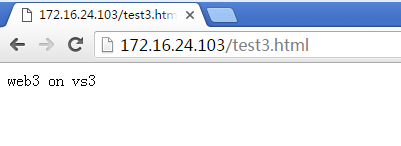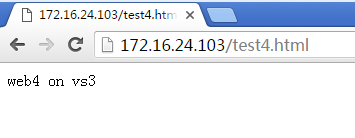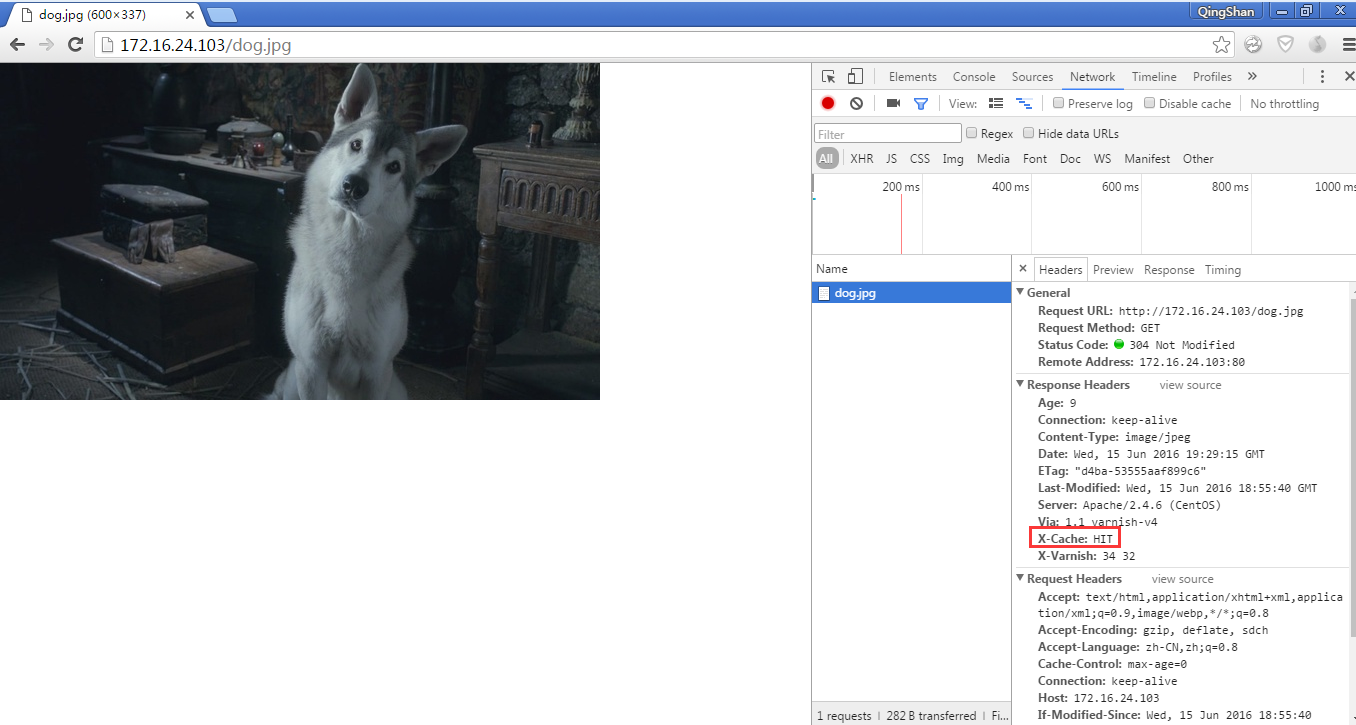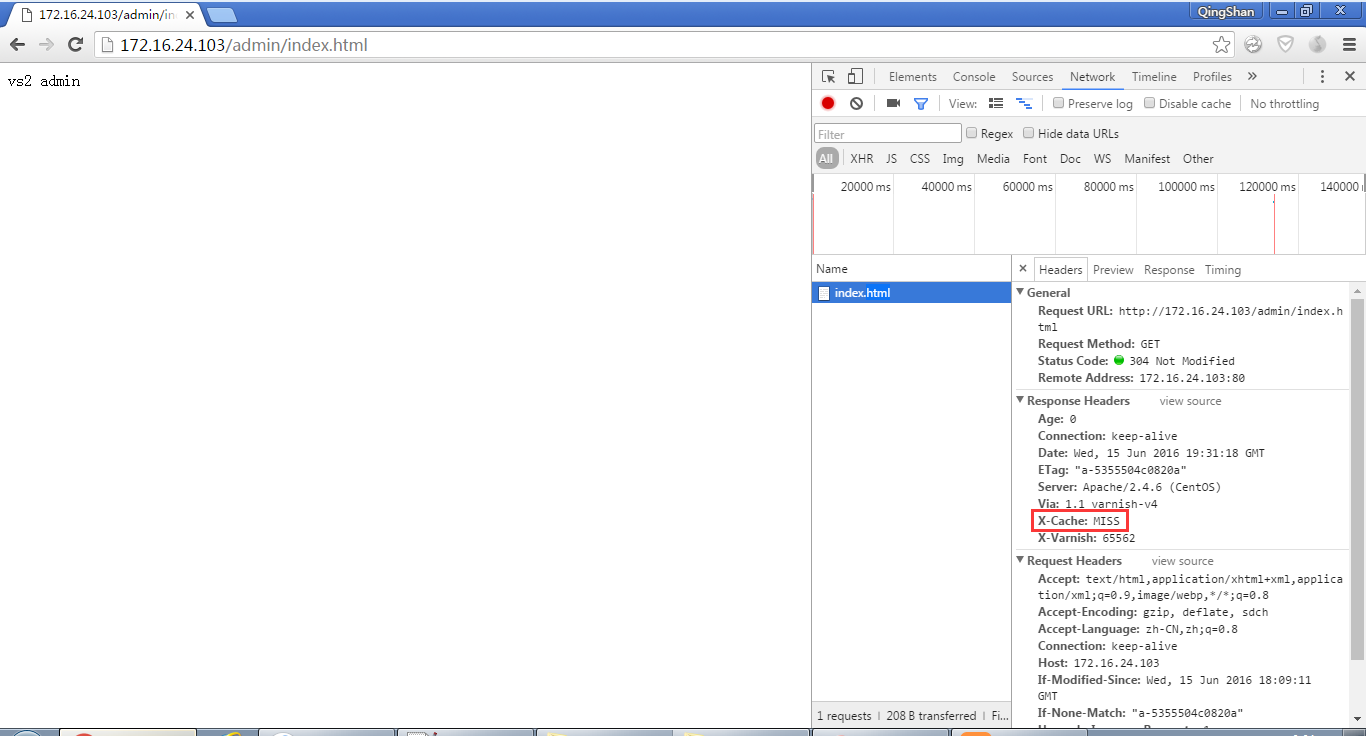varnish如何存储缓存对象:
file: 单个文件;不支持持久机制;
malloc: 缓存在内存中;
persistent:基于文件的持久存储;(此方式不建议使用)
vcl:配置缓存系统的缓存机制;【线程中缓存功能的工作机制】
一、在vs2和vs3上安装http
写入文件,内容一个为on vs2,另一个为on vs3
[root@vs2 ~]# yum install http
[root@vs2 ~]# for i in {1..10}; do echo "web$i on vs2" > /var/www/html/test$i.html; done
[root@vs2 ~]# ls /var/www/html/
test10.html test2.html test4.html test6.html test8.html
test1.html test3.html test5.html test7.html test9.html
[root@vs2 ~]# systemctl start httpd.service
二、安装varnish(在centos7上安装4.0.3版本)
[root@vs1 ~]# yum install varnish
三、varnish主程序的配置文件
[root@vs1 ~]# vim /etc/varnish/varnish.params
# Varnish environment configuration description. This was derived from
# the old style sysconfig/defaults settings
# Set this to 1 to make systemd reload try to switch vcl without restart.
RELOAD_VCL=1
# Main configuration file. You probably want to change it.
VARNISH_VCL_CONF=/etc/varnish/default.vcl #读取vcl配置文件的位置
# Default address and port to bind to. Blank address means all IPv4
# and IPv6 interfaces, otherwise specify a host name, an IPv4 dotted
# quad, or an IPv6 address in brackets.
# VARNISH_LISTEN_ADDRESS=192.168.1.5
VARNISH_LISTEN_PORT=6081 #监听的服务端口为6081
# Admin interface listen address and port
VARNISH_ADMIN_LISTEN_ADDRESS=127.0.0.1 #监听的管理地址为本机
VARNISH_ADMIN_LISTEN_PORT=6082 #监听的管理端口为6082
# Shared secret file for admin interface
VARNISH_SECRET_FILE=/etc/varnish/secret #密钥文件位置
# Backend storage specification, see Storage Types in the varnishd(5)
# man page for details.
VARNISH_STORAGE="file,/var/lib/varnish/varnish_storage.bin,1G" #缓存以文件的方式的存储位置和大小
#VARNISH_STORAGE="malooc,256M" #以内存方式缓存,缓存大小为256M
# Default TTL used when the backend does not specify one
VARNISH_TTL=120 #联系后端服务器超时时长
# User and group for the varnishd worker processes
VARNISH_USER=varnish #主进程所使用的用户
VARNISH_GROUP=varnish #主进程所使用的组
# Other options, see the man page varnishd(1) #进程选项,线程池的最大值最小值和超时时长
DAEMON_OPTS="-p thread_pool_min=5 -p thread_pool_max=500 -p thread_pool_timeout=300"
四、varnish的命令行管理工具
[root@vs1 ~]# varnishadm -S /etc/varnish/secret -T 127.0.0.1:6082
help
help [<command>] #获取帮助信息
ping [<timestamp>] #测试服务器是否正常
auth <response> #
quit #退出
banner
status #显示服务器状态信息
start #启动子进程
stop #停止子进程
vcl.load <configname> <filename> #载入哪个文件为配置文件
vcl.inline <configname> <quoted_VCLstring>
vcl.use <configname> #使用哪个vcl文件
vcl.discard <configname> #删除哪个vcl文件
vcl.list #列出所有可用的vcl文件
param.show [-l] [<param>] #显示运行时参数
param.set <param> <value>
panic.show #显示恐慌信息,显示进程或子进程上次挂掉的原因
panic.clear #清除恐慌信息
storage.list #显示缓存信息
vcl.show [-v] <configname> #显示vcl文件的详细信息,vcl编译前的样子
backend.list [<backend_expression>] #显示后端服务器列表
backend.set_health <backend_expression> <state> #手动上线下线后端服务器
ban <field> <operator> <arg> [&& <field> <oper> <arg>]... #清理缓存中的缓存对象
ban.list #显示定义的清理缓存规则
varnish的访问日志
[root@vs1 ~]# varnishlog
[root@vs1 ~]# varnishtop
varnish的统计信息
[root@vs1 ~]# varnishstat
五、vcl配置文件的说明
http://book.varnish-software.com/4.0/chapters/VCL_Basics.html
http://book.varnish-software.com/4.0/_images/simplified_fsm.svg
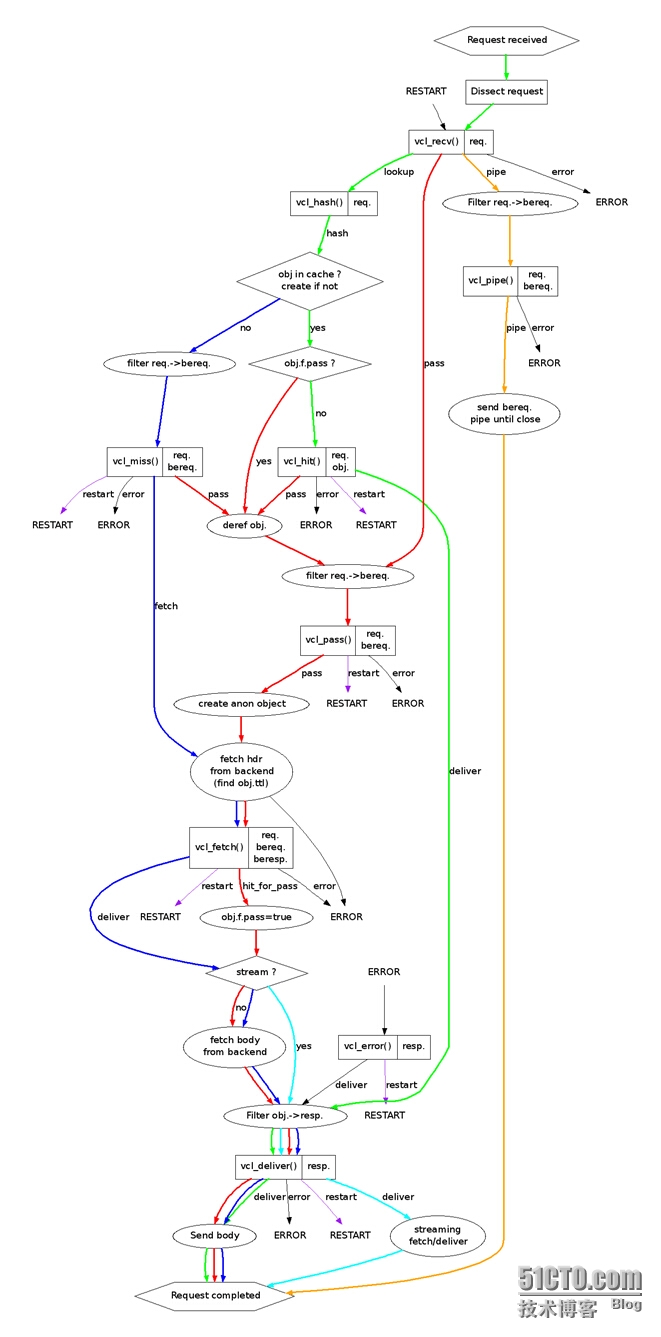
vcl_recv 接收请求
cacheable 判断是否为可缓存对象
incache 判断hash后的结果是否存在
vcl_hash 可缓存对象hash计算
vcl_hit 缓存中命中
vcl_miss 缓存中未命中
vcl_fetch 获取后端内容
vcl_deliver 构建缓存发送
vcl_pipe 客户端请求的方法不是常见方法时,直接交给后端服务器处理
vcl_pass 不检查缓存直接从后端服务器取
vcl_error varnish直接返回错误响应
六、vcl配置文件
[root@vs1 ~]# cp /etc/varnish/default.vcl /etc/varnish/test.vcl
[root@vs1 ~]# vim /etc/varnish/test.vcl
# This is an example VCL file for Varnish.
#
# It does not do anything by default, delegating control to the
# builtin VCL. The builtin VCL is called when there is no explicit
# return statement.
#
# See the VCL chapters in the Users Guide at https://www.varnish-cache.org/docs/
# and http://varnish-cache.org/trac/wiki/VCLExamples for more examples.
# Marker to tell the VCL compiler that this VCL has been adapted to the
# new 4.0 format.
vcl 4.0;
# Default backend definition. Set this to point to your content server.
backend vs2 { #定义后端主机vs2
.host = "172.16.24.102";
.port = "80";
.probe = { #对后端主机的test1进行进行健康状态检测
.url = "/test1.html";
}
}
backend vs3 {
.host = "172.16.24.104";
.port = "80";
.probe = {
.url = "/test1.html";
}
}
#import directors; #加载directors模块,在负载均衡轮询时要用到
#sub vcl_init { #轮询方式的负载均衡
# new mycluster = directors.round_robin();
# mycluster.add_backend(vs2);
# mycluster.add_backend(vs3);
#}
sub vcl_recv {
# Happens before we check if we have this in cache already.
#
# Typically you clean up the request here, removing cookies you don't need,
# rewriting the request, etc.
#url中开头带有login或者admin的直接从后端主机取结果不缓存
if (req.url ~ "(?i)^/login" || req.url ~ "(?i)^/admin") {
return(pass);
}
#url以jpg,png,gif结尾的直接发给vs2,其他的都发给vs3
if (req.url ~ "(?i)\.(jpg|png|gif)$") {
set req.backend_hint = vs2;
} else {
set req.backend_hint = vs3;
}
# set req.backend_hint = mycluster.backend(); #负载均衡集群
#如果客户端请求为PRI返回405,如果请求的为非GET,HEAD,PUT,POST,TRACE,OPTIONS,DELETE都直接发给后端主机处理
if (req.method == "PRI") {
/* We do not support SPDY or HTTP/2.0 */
return (synth(405));
}
if (req.method != "GET" &&
req.method != "HEAD" &&
req.method != "PUT" &&
req.method != "POST" &&
req.method != "TRACE" &&
req.method != "OPTIONS" &&
req.method != "DELETE") {
/* Non-RFC2616 or CONNECT which is weird. */
return (pipe);
}
if (req.method != "GET" && req.method != "HEAD") {
/* We only deal with GET and HEAD by default */
return (pass);
}
if (req.http.Authorization || req.http.Cookie) {
/* Not cacheable by default */
return (pass);
}
return (hash);
}
sub vcl_backend_response {
# Happens after we have read the response headers from the backend.
#
# Here you clean the response headers, removing silly Set-Cookie headers
# and other mistakes your backend does.
}
sub vcl_deliver {
# Happens when we have all the pieces we need, and are about to send the
# response to the client.
#
# You can do accounting or modifying the final object here.
#如果缓存能命中就在返回值中插入HIT,未命中则插入MISS
if (obj.hits>0) {
set resp.http.X-Cache = "HIT";
} else {
set resp.http.X-Cache = "MISS";
}
}
[root@vs1 ~]# varnishadm -S /etc/varnish/secret -T 127.0.0.1:6082
vcl.load test2 test.vcl
200
VCL compiled.
vcl.use test2
200
VCL 'test2' now active
七、测试
在vs2上上传一张dog.jpg,在vs3上不上传任何图片

